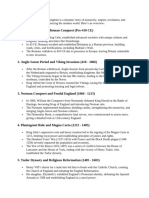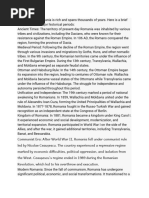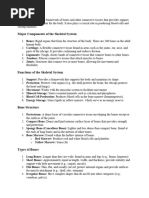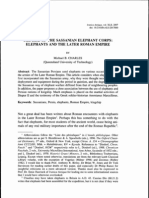The History of Myanmar
The History of Myanmar
Uploaded by
John Rex VillanuevaCopyright:
Available Formats
The History of Myanmar
The History of Myanmar
Uploaded by
John Rex VillanuevaOriginal Title
Copyright
Available Formats
Share this document
Did you find this document useful?
Is this content inappropriate?
Copyright:
Available Formats
The History of Myanmar
The History of Myanmar
Uploaded by
John Rex VillanuevaCopyright:
Available Formats
The history of Myanmar (formerly known as Burma) is marked by a rich tapestry of cultures,
kingdoms, colonial influences, and struggles for independence. Here’s an overview of the key
periods in Myanmar's history:
Ancient and Pre-Colonial Periods
Early Inhabitants: The earliest evidence of human habitation in Myanmar dates back
thousands of years, with diverse ethnic groups settling in the region. Early civilizations
developed in the fertile plains of the Irrawaddy River.
Pagan Kingdom (849 - 1297): The Pagan Kingdom is often considered the first
significant Burmese state. It emerged as a major power in the 11th century under King
Anawrahta, who unified various tribes and adopted Theravada Buddhism, establishing it
as the dominant religion. The kingdom is known for its remarkable temples, many of
which still stand today in Bagan.
Post-Pagan Period: After the decline of the Pagan Kingdom due to internal strife and
external invasions, various kingdoms emerged, including the Mon, Shan, and the
Kingdom of Ava.
Colonial Era
British Colonization (19th Century): The British began to exert control over Myanmar
in the 19th century through a series of wars, including the First Anglo-Burmese War
(1824-1826) and the Second Anglo-Burmese War (1852). By 1885, Britain had annexed
the entire country, making it a part of British India.
Economic Changes: British rule brought significant changes to the economy, with the
introduction of cash crops like rice and rubber, as well as infrastructure development,
including railways and telegraphs. However, British policies often marginalized local
industries and traditional practices.
World War II and Independence
Japanese Occupation (1942 - 1945): During World War II, Japan occupied Myanmar,
leading to widespread suffering and disruption. Many locals collaborated with the
Japanese forces in hopes of gaining independence from British rule, while others resisted.
Post-War Independence Movement: After the war, the push for independence gained
momentum. Aung San, a prominent nationalist leader, played a key role in negotiating
independence from Britain. Unfortunately, he was assassinated in 1947, just months
before independence was achieved.
Independence (1948): Myanmar officially gained independence from British rule on
January 4, 1948. However, the new nation faced immediate challenges, including ethnic
tensions, civil unrest, and the emergence of various armed groups.
You might also like
- Chapter 3 Summary Marks "Origins of The Modern World Economy"Document4 pagesChapter 3 Summary Marks "Origins of The Modern World Economy"Silvia100% (9)
- Japanese Imperialism TimelineDocument1 pageJapanese Imperialism Timelineapi-309710992No ratings yet
- French Revolution Comic StripDocument4 pagesFrench Revolution Comic Stripapi-99570533No ratings yet
- Constitutional Convention Simulation 2Document4 pagesConstitutional Convention Simulation 2api-294843376No ratings yet
- History of Cambodia Mira Bophavan DinaDocument6 pagesHistory of Cambodia Mira Bophavan DinasflwilliamworkNo ratings yet
- The History of CambodiaDocument2 pagesThe History of CambodiaJohn Rex VillanuevaNo ratings yet
- Doing Business With Asia: Asian HistoryDocument37 pagesDoing Business With Asia: Asian HistoryJuan Carlos Rivera100% (1)
- Video ScriptDocument14 pagesVideo ScriptregardezvouzNo ratings yet
- History Myanmar: PrehistoryDocument7 pagesHistory Myanmar: PrehistoryMyo Thi Ha100% (1)
- SCRIPTDocument22 pagesSCRIPTregardezvouzNo ratings yet
- Current Affairs of South East AsiaDocument7 pagesCurrent Affairs of South East AsiaLunaNo ratings yet
- 82 T Sengupta Indian Subcontinent 1750 1950 OSDocument48 pages82 T Sengupta Indian Subcontinent 1750 1950 OSmrunalNo ratings yet
- Sse 105Document6 pagesSse 105robiemayescanillaNo ratings yet
- British ColonialismDocument3 pagesBritish Colonialismt_riedl100% (1)
- The History of BritainDocument4 pagesThe History of Britainmehmeedrahman.iisdNo ratings yet
- Burma in British IndiaDocument3 pagesBurma in British IndiaKyawzinwinNo ratings yet
- History in FinlandDocument6 pagesHistory in FinlandMd. Mostafizur RahmanNo ratings yet
- The History of LaosDocument2 pagesThe History of LaosJohn Rex VillanuevaNo ratings yet
- Client State - WikipediaDocument6 pagesClient State - WikipedialosthopeornotNo ratings yet
- 3Document12 pages3Andrea MolinaNo ratings yet
- The History of SingaporeDocument1 pageThe History of SingaporeJohn Rex VillanuevaNo ratings yet
- ISBN9871271221125 'English VersionDocument109 pagesISBN9871271221125 'English VersionSocial PhenomenaNo ratings yet
- History of ThailandDocument24 pagesHistory of ThailandScribdTranslationsNo ratings yet
- British Rule in BurmaDocument4 pagesBritish Rule in Burmadfgrtg454gNo ratings yet
- The Mon HistoryDocument3 pagesThe Mon Historyminthukha100% (1)
- The History of ThailandDocument2 pagesThe History of ThailandJohn Rex VillanuevaNo ratings yet
- The History of Romania Is Rich and Spans Thousands of YearsDocument2 pagesThe History of Romania Is Rich and Spans Thousands of YearsLAM ENG HO G11L-14No ratings yet
- Jaydigdsggp Final CountryDocument48 pagesJaydigdsggp Final CountrybkaaljdaelvNo ratings yet
- Brief History ThailandDocument10 pagesBrief History Thailandsiddhartha_maity_4No ratings yet
- MALAYSIA (AutoRecovered)Document2 pagesMALAYSIA (AutoRecovered)Lucky KumarNo ratings yet
- History Twentieth Century World History 1900 To1945 in English (1)Document42 pagesHistory Twentieth Century World History 1900 To1945 in English (1)7dikshasharma8891No ratings yet
- Prehistory: Main Articles: Prehistoric Thailand, Early History of Thailand, and Tai PeoplesDocument4 pagesPrehistory: Main Articles: Prehistoric Thailand, Early History of Thailand, and Tai PeoplesAdam Bin Mat RofiNo ratings yet
- History of PhilippinesDocument2 pagesHistory of PhilippinesAzriel PocallanNo ratings yet
- Summary History of MalaysiaDocument5 pagesSummary History of Malaysialucinda_johannesNo ratings yet
- REDRWAL OF NATIONAL BOUNDARIESDocument4 pagesREDRWAL OF NATIONAL BOUNDARIESankitkumar20049065827851No ratings yet
- Imperialismo AsiaDocument3 pagesImperialismo Asiadianaotero1524No ratings yet
- ThailandDocument21 pagesThailandblawler.f24No ratings yet
- A Brief History of JapanDocument2 pagesA Brief History of JapanChan Chan GamoNo ratings yet
- Book of HanDocument2 pagesBook of HanChingkay Milo Coco Chanel GoNo ratings yet
- The History of Britain Is Long and ComplexDocument2 pagesThe History of Britain Is Long and Complexharam.6900No ratings yet
- The History of The United KingdomDocument3 pagesThe History of The United KingdomJohn Rex VillanuevaNo ratings yet
- Cambodia: A Brief History of CambodiaDocument20 pagesCambodia: A Brief History of CambodiaAnonymous rf5f9AGUNo ratings yet
- Hungarian HistoryDocument1 pageHungarian HistoryLucidny JRNo ratings yet
- Cambodia: A Brief History of CambodiaDocument7 pagesCambodia: A Brief History of CambodiaAnonymous uv2p2iNo ratings yet
- Myanmar 9 HistoryDocument27 pagesMyanmar 9 Historyguenscribd100% (1)
- Modern HistoryDocument2 pagesModern HistoryHillish SatanicNo ratings yet
- SELAMAT EMPATDocument2 pagesSELAMAT EMPATAHMAD AZIZI BIN AHMAD MoeNo ratings yet
- SELAMAT LIMADocument2 pagesSELAMAT LIMAAHMAD AZIZI BIN AHMAD MoeNo ratings yet
- Reference - Colonization EraDocument36 pagesReference - Colonization EraReen Zaza ZareenNo ratings yet
- SELAMAT DUADocument2 pagesSELAMAT DUAAHMAD AZIZI BIN AHMAD MoeNo ratings yet
- Isbn 9781229124791Document96 pagesIsbn 9781229124791Social PhenomenaNo ratings yet
- SELAMAT TIGADocument2 pagesSELAMAT TIGAAHMAD AZIZI BIN AHMAD MoeNo ratings yet
- R 4Document2 pagesR 4AlexandruNo ratings yet
- Japanese HistoryDocument2 pagesJapanese HistoryPaul Andrew TugahanNo ratings yet
- Historical Background Before & After Independence of South East Asia CountriesDocument6 pagesHistorical Background Before & After Independence of South East Asia CountriesUmmu ZubairNo ratings yet
- The Sun Never Sets: A History of British Global InfluenceFrom EverandThe Sun Never Sets: A History of British Global InfluenceNo ratings yet
- SELAMAT SATUDocument2 pagesSELAMAT SATUAHMAD AZIZI BIN AHMAD MoeNo ratings yet
- Chapter 12 OutlineDocument24 pagesChapter 12 Outlineapi-293122159No ratings yet
- Phil History3Document1 pagePhil History3Paolo LazatinNo ratings yet
- dec in asia and afrDocument28 pagesdec in asia and afrpackedright20No ratings yet
- History Of Japan For Kids: A History Series - Children Explore Histories Of The World EditionFrom EverandHistory Of Japan For Kids: A History Series - Children Explore Histories Of The World EditionNo ratings yet
- Practical Research 1 1st Summative Exam 2024-2025Document5 pagesPractical Research 1 1st Summative Exam 2024-2025John Rex VillanuevaNo ratings yet
- Families of ElementsDocument2 pagesFamilies of ElementsJohn Rex VillanuevaNo ratings yet
- The electronic configurationDocument3 pagesThe electronic configurationJohn Rex VillanuevaNo ratings yet
- SCIENCE 8 DLL Q3 WK 5Document3 pagesSCIENCE 8 DLL Q3 WK 5John Rex VillanuevaNo ratings yet
- Reseach Variables, Frameworks and Definition of TermsDocument17 pagesReseach Variables, Frameworks and Definition of TermsJohn Rex VillanuevaNo ratings yet
- Proposal Endorsement TemplateDocument1 pageProposal Endorsement TemplateJohn Rex VillanuevaNo ratings yet
- JVV Least-learned competencies 2nd QuarterDocument1 pageJVV Least-learned competencies 2nd QuarterJohn Rex VillanuevaNo ratings yet
- DLL ScienceDocument3 pagesDLL ScienceJohn Rex VillanuevaNo ratings yet
- The History of East TimorDocument2 pagesThe History of East TimorJohn Rex VillanuevaNo ratings yet
- The Digestive SystemDocument2 pagesThe Digestive SystemJohn Rex VillanuevaNo ratings yet
- The History of ChinaDocument2 pagesThe History of ChinaJohn Rex VillanuevaNo ratings yet
- S Form No. 212 Attachment Work Experience Sheet UPDATEDDocument2 pagesS Form No. 212 Attachment Work Experience Sheet UPDATEDJohn Rex VillanuevaNo ratings yet
- English 8 Pre Test and Post TestDocument6 pagesEnglish 8 Pre Test and Post TestJohn Rex VillanuevaNo ratings yet
- Skeletal SystemDocument2 pagesSkeletal SystemJohn Rex VillanuevaNo ratings yet
- Chapter 1Document7 pagesChapter 1John Rex VillanuevaNo ratings yet
- THE CHALLENGES AND COPING MECHANISM OF SELECTED SENIOR HIGHSCHOOL STUDENTS AND TEACHERS IN ENGLISH AS A MEDIUM OF INSTRUCTION IN CALASUMANGA NATIONAL HIGHSCHOOL (AutoRecovered)Document27 pagesTHE CHALLENGES AND COPING MECHANISM OF SELECTED SENIOR HIGHSCHOOL STUDENTS AND TEACHERS IN ENGLISH AS A MEDIUM OF INSTRUCTION IN CALASUMANGA NATIONAL HIGHSCHOOL (AutoRecovered)John Rex VillanuevaNo ratings yet
- Science 8 1st Periodical Exam S.Y. 2024-2025Document6 pagesScience 8 1st Periodical Exam S.Y. 2024-2025John Rex VillanuevaNo ratings yet
- Mid-Year Inset 2024 Training ProposalDocument5 pagesMid-Year Inset 2024 Training ProposalJohn Rex Villanueva75% (4)
- PHIL-IRI Reading Assessment 2nd Quarter 2023-2024Document3 pagesPHIL-IRI Reading Assessment 2nd Quarter 2023-2024John Rex VillanuevaNo ratings yet
- Action Plan 2018-2019Document4 pagesAction Plan 2018-2019John Rex VillanuevaNo ratings yet
- Questionnaire MCC - QualiDocument3 pagesQuestionnaire MCC - QualiJohn Rex VillanuevaNo ratings yet
- Form 6Document2 pagesForm 6John Rex VillanuevaNo ratings yet
- MCC Reflection 6Document2 pagesMCC Reflection 6John Rex VillanuevaNo ratings yet
- Michael Charles - The Rise of The Sasanian Elephant CorpDocument47 pagesMichael Charles - The Rise of The Sasanian Elephant CorpJohn RohdeNo ratings yet
- One Piece D20 Character Sheet: Choose An Item. Choose An ItemDocument4 pagesOne Piece D20 Character Sheet: Choose An Item. Choose An ItemrevvixNo ratings yet
- Castillo de San MarcosDocument70 pagesCastillo de San MarcosBob Andrepont100% (3)
- D&D Ship Stats - Google SearchDocument2 pagesD&D Ship Stats - Google SearchDominic Turcotte0% (1)
- The Greek Dictatorship The USA and The A PDFDocument18 pagesThe Greek Dictatorship The USA and The A PDFStavros PalatidisNo ratings yet
- "Slight Is The Subject, But Not So The Praise, If She Inspire and Approve My LaysDocument10 pages"Slight Is The Subject, But Not So The Praise, If She Inspire and Approve My LaysFatima Khalid0% (1)
- TONG HƠP BỘ ĐỀ HSG 2017Document72 pagesTONG HƠP BỘ ĐỀ HSG 2017Ngọc Anh LêNo ratings yet
- Cold War WarriorsDocument100 pagesCold War WarriorsDUXLEX100% (9)
- Grade 10-Types of ConflictsDocument15 pagesGrade 10-Types of ConflictsJov E. AlcanseNo ratings yet
- Instant download The Italian Fashion System 1st Edition Elisabetta Merlo pdf all chapterDocument60 pagesInstant download The Italian Fashion System 1st Edition Elisabetta Merlo pdf all chapterdinanwopatqo100% (10)
- City of Alaminos Ecological Profile 2019 Book ManDocument116 pagesCity of Alaminos Ecological Profile 2019 Book ManArvin Delos SantosNo ratings yet
- Phil Powrie and Keith Reader - French Cinema A Students GuideDocument221 pagesPhil Powrie and Keith Reader - French Cinema A Students GuidePatrícia KowaleskiNo ratings yet
- The Battle of The SommeDocument1 pageThe Battle of The SommeNaba AhmedNo ratings yet
- FORA JR Ranger Booklet 508cDocument16 pagesFORA JR Ranger Booklet 508cthilaxxx5913No ratings yet
- Trail of Tears Rough DraftDocument3 pagesTrail of Tears Rough DraftCharly Black0% (1)
- Osprey - Campaign - 201 - Brandy Station 1863 - First Step Towards GettysburgDocument97 pagesOsprey - Campaign - 201 - Brandy Station 1863 - First Step Towards GettysburgDruh Bruchwicz100% (10)
- Specialization: Licensure Examination For TeachersDocument14 pagesSpecialization: Licensure Examination For Teachersarnel t. ebordeNo ratings yet
- Carta de Lenin A GorkiDocument3 pagesCarta de Lenin A GorkiRaúl CazalNo ratings yet
- Myanmar's Rocky Road To Democracy: A New Game of The Generals? by Marishka CabreraDocument2 pagesMyanmar's Rocky Road To Democracy: A New Game of The Generals? by Marishka CabrerathecenseireportNo ratings yet
- FINKELBERG 2011 The Homer Enciclopedya 1Document374 pagesFINKELBERG 2011 The Homer Enciclopedya 1Cecilia100% (6)
- ATMIS Military Officers Complete Training To Bolster Mission ObjectivesDocument4 pagesATMIS Military Officers Complete Training To Bolster Mission ObjectivesAMISOM Public Information ServicesNo ratings yet
- 1Document217 pages1Aris MaravasNo ratings yet
- Risk-Assessment-For-Insider-Threat-Critical-Infrastructure-Military-And-Intelligence - Content File PDFDocument27 pagesRisk-Assessment-For-Insider-Threat-Critical-Infrastructure-Military-And-Intelligence - Content File PDFMihai DecebalNo ratings yet
- Ocs PDFDocument2 pagesOcs PDFSabrinaNo ratings yet
- Relationship Between State and Civil Society: Theoretical ReviewDocument9 pagesRelationship Between State and Civil Society: Theoretical ReviewmetaNo ratings yet
- Gaslands Bases - General Rules-1Document1 pageGaslands Bases - General Rules-1korkie100% (1)
- The PR Practitioner's Desktop Guide AjcDocument266 pagesThe PR Practitioner's Desktop Guide AjcTao Huyen Trang100% (1)
- Syllabus - Edu153 - World History 2Document11 pagesSyllabus - Edu153 - World History 2genesisgamaliel montecino100% (1)
















































































































